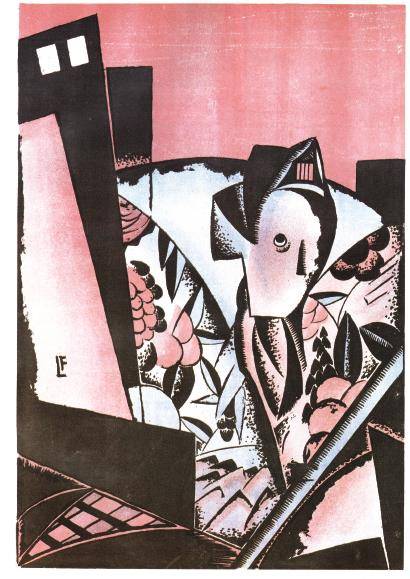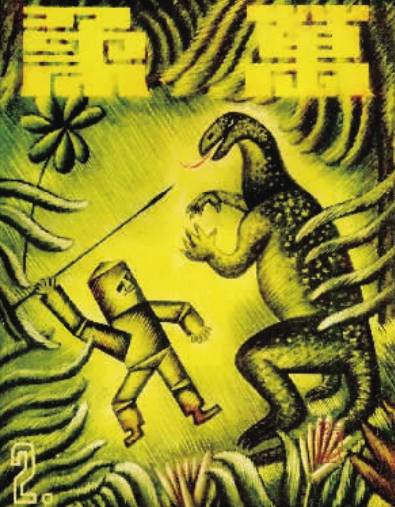Guo Jianying’s illustrator “Every Mother Knows”, 1930
The “Outstanding” and “Failure” of “Midnight”
Mao Dun’s representative work “Midnight” is the most famous left-wing urban novel, full of satire on the capitalist world, but the attitudes of European and American sinologists are quite different. The study of “Midnight” in European sinology circles is very popular, and most sinologists highly recognize “Midnight”. In the eyes of the Soviet Sinologist Vladislav F. Sorokin, Midnight has a unique artistic charm. Mao Dun used the artistic techniques of a realist master to create a huge picture scroll of Chinese social life. Jaroslav Prusek, a Czechoslovakian sinologist, believes that Midnight is no less than the first-class literature in Europe. In his opinion, Midnight uses the writing method of European classical realism novels, pays attention to the visualization of inner monologue, pursues objectivity, has extraordinary descriptive ability, vivid details and rich language, which is comparable to Tolstoy’s works. Midnight is also widely favored in the German and French-speaking world, and is regarded as an important text for the study of modern Chinese revolutionary thought. German sinologist Wolfgang Kubin endorsed Midnight as “the first outstanding modern Chinese novel that has not lost its significance and influence so far”, and French sinologist Michelle Loi also praised it With its vigorous style and strong authenticity, “Midnight” has achieved great success and deserves the pride of the Chinese people.
In the United States, the study of “Midnight” was once interfered by ideology. It started late and the evaluation was low: as the pioneer of the study of “Midnight” in the United States, Xia Zhiqing made great fire on it in “History of Modern Chinese Fiction” (1961). Kai regarded “Midnight” as a “failure” and deliberately elevated the status of Mao Dun’s early novels such as “Eclipse” and “Rainbow”. This attitude has far-reaching influence on American academic circles.
It is not difficult to detect Xia Zhiqing’s “drunkard’s meaning”. After all, the Soviet Sinologist Nikolay Trofimovich Fedorenko praised “Midnight” as Mao Dun’s most outstanding work, and “Midnight” was the Czech translator of “Midnight” by Pushk, the head of the Prague Sinology School. The greatest literary work in China other than the classics of Lu Xun. During the Cold War, the confrontation between the two camps spread to the field of Sinology, which was prominently displayed in the “Battle of Puxia” in the 1960s. Pushker criticized Xia Zhiqing, Mao Dun and other left-wing writers with sarcasm and indifference, accusing Xia of not understanding the author’s creative intentions, not conducting scientific analysis, and his criticism of “Midnight” was unfair. In his response, Xia Zhiqing countered that Pushker was a left-wing critic, and his evaluation of Mao Dun’s works placed too much emphasis on political rather than artistic value.
The “Battle of Puxia” stirred up waves in the sinology circles in Europe and the United States. Under the stimulation of Pushker, Xia Zhiqing’s attitude towards Chinese left-wing literature changed; Pushker also played down political standards in his research and cultivated between lyricism and epic. After the 1970s, Sino-US relations improved, and the research on Mao Dun in the United States gradually increased, but he paid more attention to his early novels and avoided Midnight consciously or unintentionally. Since the 1990s, American sinologists have changed their attitude towards Midnight, focusing on interpreting it from the perspective of urban culture and exploring its deep value in combination with theories of psychology, modernity, and women. In the new century, European sinologists gradually anthropomorphized “Midnight” and regarded it as an important text for the study of Shanghai and even China’s urban modernization. “Midnight” has gradually evolved from a “political novel” mainly used to observe the Chinese revolution in the sinology circles in Europe and the United States to an “ethnography” to study the modernization of Chinese cities. This change reflects a deeper shift of power behind it: political factors , the search for commonalities, and the growing interest in modern China.

Ye Lingfeng painted the cover of “Shanghai Comics” (issue 37) on December 29, 1928
From Urban Modernism to Urban Montage
The 1930s were not only the era of Midnight, but also the era when modernist novels were popular in Shanghai. Modern literature is in line with the world, and the European and aesthetic circles are very interested in it, which is no problem. Li Oufan, who is “fascinated by modernism”, regarded Shi Zhecun, Liu Naou, Mu Shiying, Ye Lingfeng, Shao Xunmei and other writers as “urban modernists” and explored them one by one. His research has two characteristics. It is placed in the context of Chinese modernist literature and is close to the literary scene; the second is to focus on discussing literature from the perspective of urban culture, and to be concerned about Shanghai and modern China. Scholars such as Shi Shumei, Heinrich Fruehauf, and Yomi Braester have all embarked on the road of modernist novel research under the guidance of Li Oufan, combining postcolonialism, orientalism, popular culture, urban space, culture Identity and other theories are deeply cultivated. Their research shows that the multilingual environment of Shanghai is the soil for nurturing modernist literature and art. Shanghai writers represented by modernist novelists boldly imitated, transformed and replaced the exoticism from France, breaking through the category of Western modernist literature. It shows the diversity and richness of Chinese literature. The new women in the modernist novels are the products of modern times, and have obvious world tastes in literature and music, which are not found in most of the May Fourth novels. Although the main force of contemporary American Sinology is Chinese living in the United States, the study of Chinese modernist novels in the United States has attracted many non-Chinese scholars to join, many of whom have cross-cultural backgrounds.
Although Europe’s research in this area is not as large as that of the United States, they are good at discovering the connection between Chinese novelists and Europe, and are good at examining Chinese modernist novels from the macro perspective of the world‘s modernist literature and art trends, and discover novelists and poets with similar styles of the same era. Interaction with the artist. French sinologists Qsabelle Rabut, Angle Pino and his wife, Kubin from Germany, Lena Scheen from the Netherlands, and Paul Bevan from the UK have all conducted relevant research. Among them, Bi Wen’s monograph “Intoxicating Shanghai – Urban Montage: The Art and Literature of Shanghai Pictorial in the Jazz Age” (‘Intoxicating Shanghai’) is the most notable. His new theory of “urban montage” focuses on the modernist-centered Shanghai writers and artists of the 1930s, placing their works in the context of Shanghai’s literary and artistic production, focusing on art, literature, film, music and dance halls He believes that artists such as Guo Jianying and Ye Qianyu who work closely with modernist novelists should be included in the research field. He also found the overlap between Lu Xun and the urban modernists: they lived together in Shanghai in the 1930s, sharing hobbies such as film and art, and foreign films and literature and art brought them a steady stream of inspiration.
The classical sinology tradition, profound accumulation of poetry and art possessed by European sinologists prompted them to bring Chinese modernist novels, poetry and art into the perspective of world modernism as a whole; American sinologists who experienced the wave of urbanization in the 20th century were keen to learn from From the perspective of modern urban culture, the study of Chinese modernist novels is not only a collective nostalgia for Shanghai, but also a cultural comparison that promotes oneself and others. The constant introduction of new research in European and aesthetic circles shows the worldwide significance of this theme.

Zhang Guangyu painted the cover of “Vientiane” (issue 2) June 1934
The urban culture of “Magic City”
Chinese modernist novelists are good at writing about the bright surface of cities and the changes brought about by modernization and urbanization, while left-wing urban writers are good at exposing the sense of grotesque and crisis brought about by colonialism and imperialism. Their differences in cognition just reflect the heterogeneity of Shanghai residents who are mainly immigrant and the mixed identity in terms of identity. As the scholar Liu Jianhui said: “The traditional space with a history of more than 700 years centered on the old Shanghai county town and the modern space with a history of only more than 100 years centered on the concessions divide Shanghai into two areas with completely different properties. … Shanghai It has formed a hybridity in urban space and culture, prompting its radical ‘magic nature’, so that it has been dubbed the ‘magic capital’.” Shanghai culture has Jiangnan heritage and world vision, local awareness and national feelings, and pragmatism. With the characteristics of both attitude and innovative spirit, left-wing urban novels and modernist novels can coexist in Shanghai in the same period while retaining their own characteristics.
In March 1930, the China Left-wing Writers’ Union (referred to as “Left-wing”) was established in Shanghai. In fact, the Left Alliance and the Modernists are not only active in the same time and space, but also have a lot of overlap in terms of personnel composition and literary style. Zuolian was established in China Art University on North Sichuan Road, and its main activities were in the area of Duolun Road, North Sichuan Road; the Shuimo Bookstore, edited by Dai Wangshu and Shi Zhecun, was located not far away from Public Welfare Square (now North Sichuan Road) No. 989 Sichuan North Road). In 1928, Feng Xuefeng, a left-wing cultural leader, became a guest of Shuimo Bookstore, leading them to contact with Japanese left-wing literature. The bookstore published novels by left-wing writers such as Ding Ling, Hu Yepin and Rou Shi. Dai Wangshu and Du Heng also participated in the left-wing literature under the introduction of Feng Xuefeng. Joint founding meeting and became the first batch of members. After the 1930s, left-wing literati and modernists gradually drifted apart. Lou Shiyi, Qian Xingcun and others criticized Shi Zhecun with “New Sensualism”, and modernist novelists were regarded as “New Sensualism”. However, Lou Shiyi’s urban novel “Shanghai Rhapsody” written in 1931 also has a distinct modernist style. Mao Dun’s novel “Midnight” also has a similar performance. There is no need to be confused if Neo-Sensualism is seen as a new expressive way of writing about the modern city.
* * *
As “outsiders”, European and American sinologists provide us with another way of thinking. In their view, left-wing urban novels and modernist novels are both products of Shanghai’s urban culture, drawing on the serial novels of the late Qing Dynasty and the early Republic of China, and the city and women are their common objects of concern. Modern intellectuals living in Shanghai have easy access to Western urban culture. They were deeply influenced by it, but also had a deeper understanding of the humiliation of colonialism, and thus became strong resisters of imperialism and colonialism. They do not see foreign culture as a substitute for Chinese culture, but as an aid to build Chinese modernity. Writers participated in shaping Shanghai’s modernity by creating novels and related characters, and later European and American scholars observed Shanghai and modern China through the “literary Shanghai” created by writers and artists.
Author: Di Xiachen
Editor: Liu Di
Responsible editor: Yang Yiqi
*Wenhui’s exclusive manuscript, please indicate the source when reprinting.Return to Sohu, see more
Editor:
Disclaimer: The opinions of this article only represent the author himself, Sohu is an information publishing platform, and Sohu only provides information storage space services.